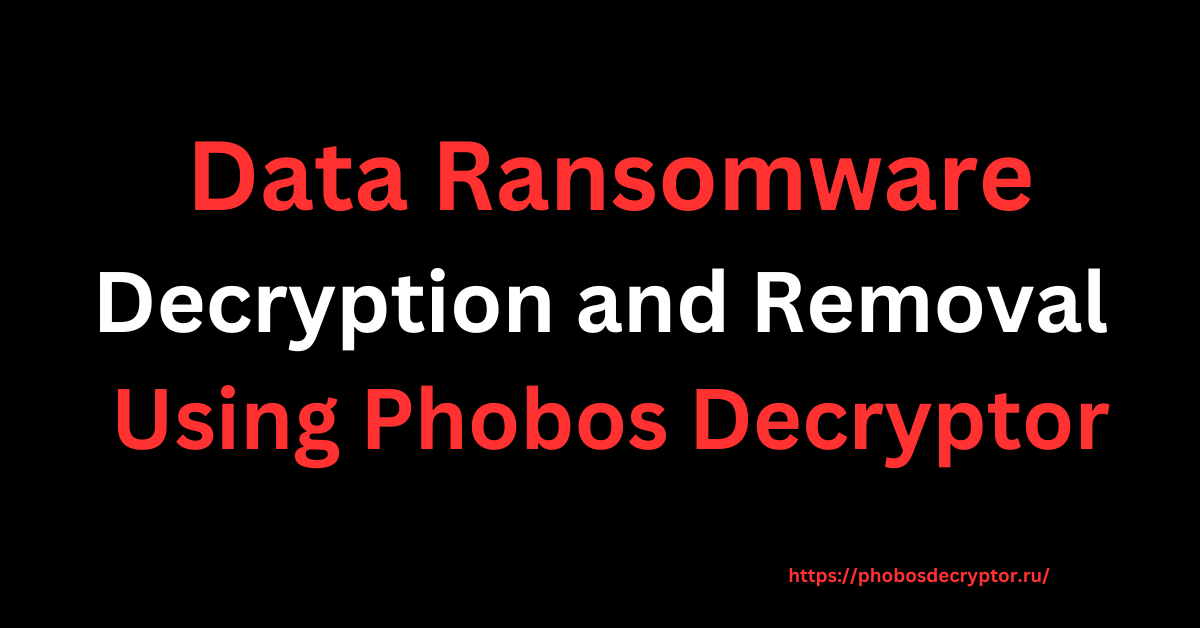Introduction
Data ransomware is a malicious software belonging to the notorious Proton ransomware family, designed to encrypt victims’ files and demand payment for their restoration. This ransomware appends the “.data3” extension to affected files, rendering them inaccessible. For instance, a file named “document.txt” would be transformed into “document.txt.[[email protected]].data3” following encryption.
Related article: Mamona Ransomware Decryption and Removal Using Phobos Decryptor
Understanding Data Ransomware
Infection Vector
Data ransomware primarily spreads through:
- Phishing Emails: Attackers send emails with malicious attachments or links, tricking users into executing the ransomware.
- Malicious Advertisements: Users clicking on deceptive ads may unknowingly download the ransomware.
- Software Vulnerabilities: Exploiting unpatched software or operating system vulnerabilities to infiltrate systems.
Encryption Mechanism
Upon execution, Data ransomware scans the system for various file types, including documents, images, and databases. It employs robust encryption algorithms, making decryption without the attackers’ assistance nearly impossible. Each encrypted file receives the “.data3” extension, and the ransomware generates a unique identifier for the victim.
Also read: Nightspire Ransomware Decryption and Removal Using Phobos Decryptor
Ransom Note Details
After encryption, Data ransomware delivers a ransom note titled “#Read-for-recovery.txt” and alters the desktop wallpaper to instruct victims on contacting the attackers. The note typically includes:
- Primary Email: [email protected]
- Secondary Email: [email protected]
- Instructions: Victims are directed to send messages to both emails and check their spam folders regularly.
- Unique ID: A specific identifier assigned to the victim.
The ransom note advises victims to create a new email account (e.g., Gmail or Outlook) if no response is received within 24 hours.
Full Ransom Note Content:
Email 1:
Email 2:
Send messages to both emails at the same time
So send messages to our emails, check your spam folder every few hours
ID: –
If you do not receive a response from us after 24 hours, create a valid email, for example, gmail, outlook
Then send us a message with a new email
Association with the Proton Ransomware Family
Data ransomware is identified as a variant within the Proton ransomware family. Proton has undergone several iterations since its emergence, with variants like Zola introducing features such as privilege escalation and disk overwriting functions. These evolutions indicate the adaptability and continuous development of the Proton family to enhance its effectiveness and evade detection.
Preventive Measures
To safeguard against Data ransomware and similar threats:
- Regular Backups: Maintain offline backups of critical data to ensure recovery without paying ransoms.
- Email Vigilance: Exercise caution with unsolicited emails, especially those containing attachments or links.
- System Updates: Keep operating systems and software up-to-date to patch vulnerabilities.
- Security Software: Utilize reputable antivirus and anti-malware solutions, ensuring they are regularly updated.
Response to Infection
If infected:
- Isolate the System: Disconnect from networks to prevent the spread.
- Avoid Paying the Ransom: There’s no guarantee of data recovery, and it may encourage further criminal activity.
- Consult Professionals: Seek assistance from cybersecurity experts or local authorities.
- Restore from Backups: If available, use backups to recover data after ensuring the system is clean.
Recovering Files Encrypted by Data Ransomware: Can Phobos Decryptor Help?
If your files have been locked with the .data3 extension due to a Data ransomware attack, you might feel like your data is lost forever. But don’t worry—Phobos Decryptor is here to help you restore your encrypted files safely and efficiently, without paying a ransom.
How Phobos Decryptor Can Help With Data Ransomware?
Phobos Decryptor is a specialized tool built to counter ransomware threats like Data. It uses advanced decryption algorithms that work specifically against this ransomware, helping you recover your files without any risk of corruption or data loss.
Why Phobos Decryptor is the Best Solution for Data Ransomware Recovery?
- Tailor-Made Decryption – Phobos Decryptor is engineered to decrypt .data3 encrypted files, leveraging deep insights into the ransomware’s encryption methods.
- Easy to Use – No technical skills needed! Phobos Decryptor features a simple, user-friendly interface that lets you recover your files in just a few clicks.
- 100% Data Integrity – Unlike unreliable solutions, Phobos Decryptor ensures that your files remain intact and fully functional after decryption.
How to Use Phobos Decryptor for .data3 Encrypted Files?
If you’re ready to recover your files from Data ransomware, follow these simple steps:
- Purchase Phobos Decryptor – Get the tool from us to ensure a safe and guaranteed decryption process.
- Run the Tool as Administrator – Launch the decryptor with administrative privileges. Ensure your device is connected to the internet.
- Connect to Our Secure Servers – The decryptor will sync with our secure servers, generating the necessary decryption keys for your files.
- Enter Your Victim ID – Find your Victim ID (usually included in the ransom note “#Read-for-recovery.txt” or file name format: “file.jpg.[[email protected]].data3”). Enter this into Phobos Decryptor.
- Start Decryption – Click “Decrypt”, and Phobos Decryptor will work through your files, restoring them to their original state.
Also read: P*zdec Ransomware Decryption and Removal Using Phobos Decryptor
Why Choose Phobos Decryptor?
- The Only Proven Solution – Phobos Decryptor is designed specifically for Data ransomware, ensuring high success rates.
- Guaranteed File Safety – Unlike other methods, our decryptor protects your data, keeping files intact and uncorrupted.
- 24/7 Expert Support – Need help? Our team offers remote assistance to guide you every step of the way.
Conclusion
Data ransomware, with its “.data3” extension, exemplifies the evolving nature of cyber threats. Understanding its mechanisms and maintaining proactive cybersecurity practices are essential in mitigating risks and ensuring data integrity.

1 thought on “Data Ransomware Decryption and Removal Using Phobos Decryptor”